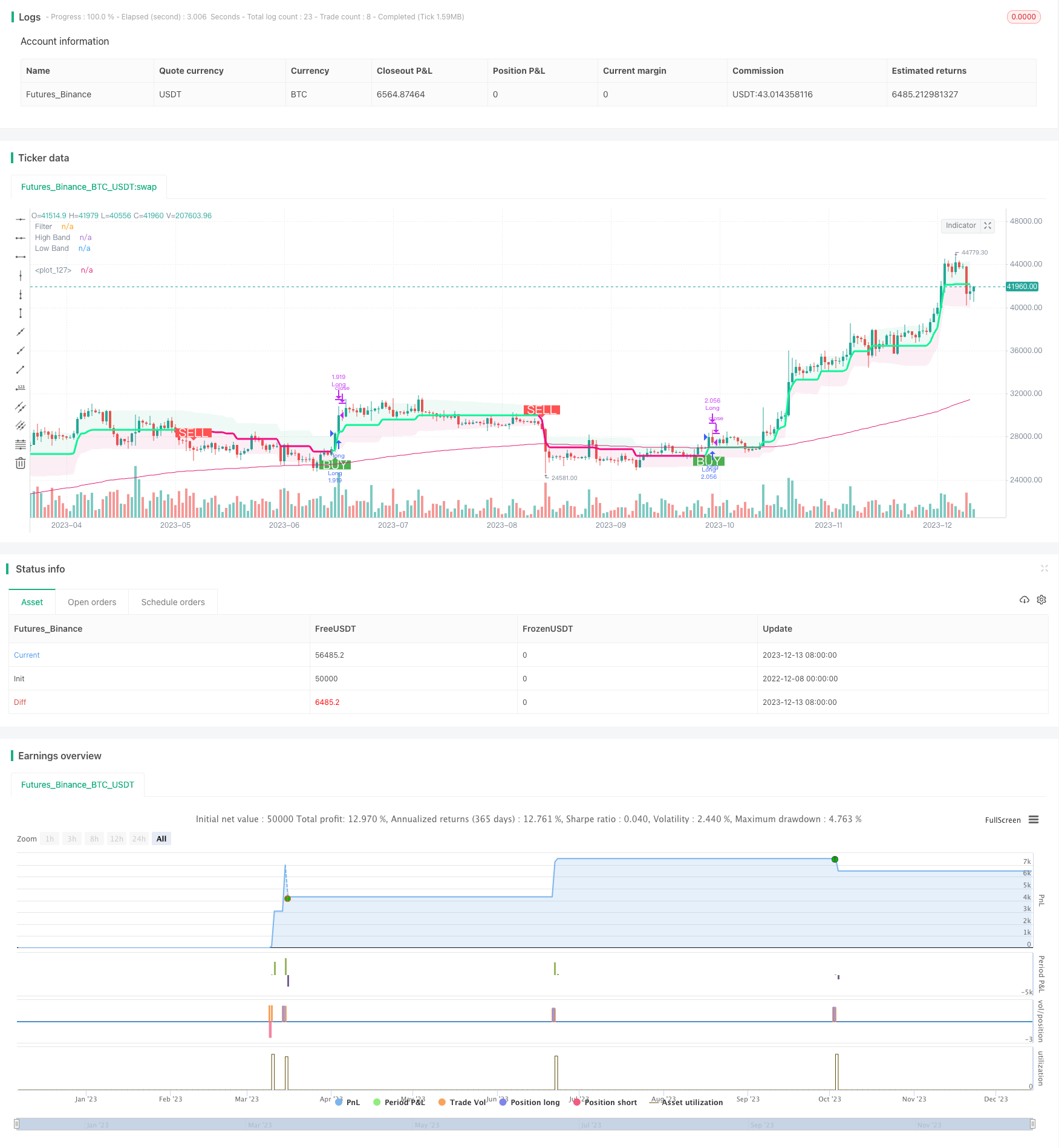
概述
双向价格突破均线选时交易策略(Dual Direction Price Breakthrough Moving Average Timing Trading Strategy)是一个利用价格突破均线来判断买卖时机的量化交易策略。该策略使用价格与指定周期的移动平均线做比较,根据价格上穿或下穿均线来产生交易信号。
策略原理
该策略的核心逻辑是:
使用EMA函数计算指定周期(如200天)的移动平均线(EMA)。
比较收盘价与EMA的大小关系,判断价格是否突破EMA。具体来说,当天收盘价大于EMA时,认为价格上穿EMA;当天收盘价小于EMA时,认为价格下穿EMA。
根据上穿和下穿来判断买卖时机。当价格上穿EMA时,产生买入信号;当价格下穿EMA时,产生卖出信号。
在产生信号时,按一定比例(如全仓)下单,然后设置止损和止盈价格。
当价格达到止损或止盈价格时,平掉头寸。
如此循环,利用价格突破均线的时机性来获利。
该策略简单直接,容易理解和实现。通过捕捉短线上的突破信号来获得较好的时机性。但也存在一定的滞后性和多次震荡的风险。
策略优势
- 策略逻辑简单清晰,容易理解和验证。
- 利用均线特征,有一定的趋势跟踪能力。
- 交易次数多,适合短线操作。
- 可以快速响应价格变化,捕捉较好的时机。
策略风险
- 有一定的滞后性,可能漏掉价格最初的突破。
- 多次突破震荡时,容易产生交易频繁的问题。
- 大幅反转时,止损有被套的可能。
可以通过参数调整来优化,比如调整均线参数,使用更高效的指标判断,降低交易频率等方法。也可以设置adaptive止损或引入过滤条件等手段来控制风险。
策略优化方向
- 尝试不同类型和参数的均线指标,寻找更优解。如EMA,SMA,LWMA等。
- 增加过滤条件,避免多次震荡交易。如引入成交量,布林线,ATR等辅助判断。
- 优化和测试止损止盈策略,降低风险。
- 结合趋势和反转等多种策略思路,建立综合性的交易体系。
- 增加参数化配置,使策略更具普适性。
总结
本策略整体较为简单直观,核心思路是跟踪均线来捕捉价格的短期突破。优点是反应敏捷,易于实现;缺点是滞后性和迟缓性。后期可从指标选择、止损机制、过滤手段等方面进行优化,使策略更加稳定和全面。
策略源码
/*backtest
start: 2022-12-08 00:00:00
end: 2023-12-14 00:00:00
period: 1d
basePeriod: 1h
exchanges: [{"eid":"Futures_Binance","currency":"BTC_USDT"}]
*/
// This source code is subject to the terms of the Mozilla Public License 2.0 at https://mozilla.org/MPL/2.0/
// Credits to the original Script - Range Filter DonovanWall https://www.tradingview.com/script/lut7sBgG-Range-Filter-DW/
// This version is the old version of the Range Filter with less settings to tinker with
//@version=5
strategy(title='Range Filter - B&S Signals', shorttitle='RF - B&S Signals', initial_capital=1000, currency=currency.GBP, default_qty_value=100, default_qty_type=strategy.percent_of_equity, commission_type=strategy.commission.percent, commission_value=0.075, overlay=true)
i_startTime = input(defval=timestamp('01 Jan 2020 12:00 +0000'), title='Backtest Start')
i_endTime = input(defval=timestamp('01 Jan 2024 12:00 +0000'), title='Backtest End')
inDateRange = true
//-----------------------------------------------------------------------------------------------------------------------------------------------------------------
//Functions
//-----------------------------------------------------------------------------------------------------------------------------------------------------------------
longLossPerc = input.float(title='Long Stop Loss (%)', minval=0.0, step=0.1, defval=1) * 0.01
shortLossPerc = input.float(title='Short Stop Loss (%)', minval=0.0, step=0.1, defval=1) * 0.01
longTakePerc = input.float(title='Long Take(%)', minval=0.0, step=0.1, defval=1) * 0.01
shortTakePerc = input.float(title='Short Take (%)', minval=0.0, step=0.1, defval=1) * 0.01
emaLength = input.int(200, title="EMA Length")
// Determine stop loss price
//Range Size Function
rng_size(x, qty, n) =>
// AC = Cond_EMA(abs(x - x[1]), 1, n)
wper = n * 2 - 1
avrng = ta.ema(math.abs(x - x[1]), n)
AC = ta.ema(avrng, wper) * qty
rng_size = AC
rng_size
//Range Filter Function
rng_filt(x, rng_, n) =>
r = rng_
var rfilt = array.new_float(2, x)
array.set(rfilt, 1, array.get(rfilt, 0))
if x - r > array.get(rfilt, 1)
array.set(rfilt, 0, x - r)
if x + r < array.get(rfilt, 1)
array.set(rfilt, 0, x + r)
rng_filt1 = array.get(rfilt, 0)
hi_band = rng_filt1 + r
lo_band = rng_filt1 - r
rng_filt = rng_filt1
[hi_band, lo_band, rng_filt]
//-----------------------------------------------------------------------------------------------------------------------------------------------------------------
//Inputs
//-----------------------------------------------------------------------------------------------------------------------------------------------------------------
//Range Source
rng_src = input(defval=close, title='Swing Source')
//Range Period
rng_per = input.int(defval=20, minval=1, title='Swing Period')
//Range Size Inputs
rng_qty = input.float(defval=3.5, minval=0.0000001, title='Swing Multiplier')
//Bar Colors
use_barcolor = input(defval=false, title='Bar Colors On/Off')
//-----------------------------------------------------------------------------------------------------------------------------------------------------------------
//Definitions
//-----------------------------------------------------------------------------------------------------------------------------------------------------------------
//Range Filter Values
[h_band, l_band, filt] = rng_filt(rng_src, rng_size(rng_src, rng_qty, rng_per), rng_per)
//Direction Conditions
var fdir = 0.0
fdir := filt > filt[1] ? 1 : filt < filt[1] ? -1 : fdir
upward = fdir == 1 ? 1 : 0
downward = fdir == -1 ? 1 : 0
//Trading Condition
longCond = rng_src > filt and rng_src > rng_src[1] and upward > 0 or rng_src > filt and rng_src < rng_src[1] and upward > 0
shortCond = rng_src < filt and rng_src < rng_src[1] and downward > 0 or rng_src < filt and rng_src > rng_src[1] and downward > 0
CondIni = 0
CondIni := longCond ? 1 : shortCond ? -1 : CondIni[1]
longCondition = longCond and CondIni[1] == -1
shortCondition = shortCond and CondIni[1] == 1
//Colors
filt_color = upward ? #05ff9b : downward ? #ff0583 : #cccccc
bar_color = upward and rng_src > filt ? rng_src > rng_src[1] ? #05ff9b : #00b36b : downward and rng_src < filt ? rng_src < rng_src[1] ? #ff0583 : #b8005d : #cccccc
ema = ta.ema(close,emaLength)
//-----------------------------------------------------------------------------------------------------------------------------------------------------------------
//Outputs
//-----------------------------------------------------------------------------------------------------------------------------------------------------------------
longStopPrice = strategy.position_avg_price * (1 - longLossPerc)
shortStopPrice = strategy.position_avg_price * (1 + shortLossPerc)
longTakePrice = strategy.position_avg_price * (1 + longTakePerc)
shortTakePrice = strategy.position_avg_price * (1 - shortTakePerc)
//Filter Plot
filt_plot = plot(filt, color=filt_color, linewidth=3, title='Filter', transp=67)
//Band Plots
h_band_plot = plot(h_band, color=color.new(#05ff9b, 100), title='High Band')
l_band_plot = plot(l_band, color=color.new(#ff0583, 100), title='Low Band')
//Band Fills
fill(h_band_plot, filt_plot, color=color.new(#00b36b, 92), title='High Band Fill')
fill(l_band_plot, filt_plot, color=color.new(#b8005d, 92), title='Low Band Fill')
//Bar Color
barcolor(use_barcolor ? bar_color : na)
if inDateRange and close>ema
strategy.entry("Long", strategy.long, when=longCondition)
if inDateRange and close<ema
strategy.entry("Short", strategy.short, when=shortCondition)
plot(ema)
//Plot Buy and Sell Labels
plotshape(longCondition, title='Buy Signal', text='BUY', textcolor=color.white, style=shape.labelup, size=size.normal, location=location.belowbar, color=color.new(color.green, 0))
plotshape(shortCondition, title='Sell Signal', text='SELL', textcolor=color.white, style=shape.labeldown, size=size.normal, location=location.abovebar, color=color.new(color.red, 0))
//Alerts
alertcondition(longCondition, title='Buy Alert', message='BUY')
alertcondition(shortCondition, title='Sell Alert', message='SELL')
if strategy.position_size > 0
strategy.exit(id='Long', stop=longStopPrice, limit=longTakePrice)
if strategy.position_size < 0
strategy.exit(id='Short', stop=shortStopPrice, limit=shortTakePrice)